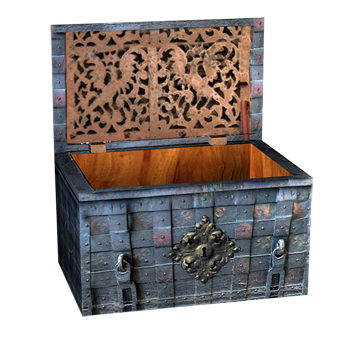Object Descriptions Tower House Bedroom
Chest
A good place to put money or other precious objects in a tower house was on the top floor, because that would be the hardest place for an invader or thief to reach.
The metal chest here is of the kind with elaborate locking mechanisms.
The chest is a Spanish model; Spenser could have purchased or salvaged similar models from the flotsam and jetsam washed up on Irish shores in the sixteenth century, including after ships from the Great Armada crashed there in 1588 (see also Great Hall: helmet, Spanish). In 1587, in a brief period of piracy (or opportunism, depending on the legal interpretation), Spenser captained a seized Spanish ship, loaded with wine, and sailed it from the Dingle Peninsula in County Kerry to Cork harbor.

Literary Connections
Spenser's employer Arthur, Lord Grey wrote to Queen Elizabeth during the Desmond rebellion that the Spanish besieged at Smerwick had a ”coffer” in which they stored all their ”treasure.” It was duly seized and its contents of silver (“plate“) coins distributed among his men.
The Munster Plantation offered Spenser himself significant opportunity in land, treasure and status. He, like his fellow New Englishmen, or like Guyon, the hero of Temperance who resists the snares of Mammon (in Book II of The Faerie Queene), had to be on guard against its corrupting influences. He also had to guard against thieves.
The treasure inside the chest might remind us of Spenser’s bride, described in Amoretti 15 as containing “all this worlds riches that may farre be found.” Her lips are like “Rubies,” her eyes like “Saphyres,” and so forth, but most fair of all is “her mind adornd with vertues manifold.” In the following wedding poem, “Epithalamion,” we hear that “all her body” is “like a pallace fayre,/ Ascending vppe with many a stately stayre,/ To honors seat and chastities sweet bowre” (178-80). Elizabeth Boyle was herself a prize to be won.
A chest lost at sea is fought over by two sons of “Milesio,” Amidas and Bracidas, in Book V of The Faerie Queene (the “Book of Justice”). Artegall, the hero of Justice, finds Amidas and Bracidas fighting over a
… Coffer strong,
Fast bound on euery side with iron bands,
But seeming to haue suffred mickle wrong,
Either by being wreckt vppon the sands,
Or being carried farre from forraine lands. (FQ V.iv.5.1-5)
The ensuing story involves a complicated legal matter, involving a dispute over land lost and found (land washed from one brother to the other by action of the sea), wives lost and found (the wife of one brother eloped with the other; the other wife floated back the other way), as well as treasure lost and found (the chest floated, accompanied by wife, from the one brother to the other). Artegall, acting as judge, resolves the dispute through the principle of salvage (or, put crudely, finders-keepers): to whom the land, treasure and wife goes, thanks to the action of the sea, so belongs the ownership of each:
For what the mighty Sea hath once possest,
And plucked quite from all possessors hand,
Whether by rage of waues, that neuer rest,
Or else by wracke, that wretches hath distrest,
He [i.e., the Sea] may dispose by his imperiall might,
As thing at randon left, to whom he list. (FQ V.iv.19.2-7)
The episode has clear Irish significance in that Milesio was the legendary king of Spain who colonized prehistoric Ireland, according to Irish legend. His descendants were the Irish themselves. In Spenser’s poem, however, it is possible that one brother stands allegorically for Ireland and the other for England, Scotland and/or Wales. In either case, the resolution offered here indicates that Spenser fantasized about such a judgment being applied to his Irish situation. Artegall’s decision echoes the judgment of Dame Nature in The Faerie Queene Book VII (“The Mutabilitie Cantos”), which occurs on Arlo Hill, near Kilcolman: in that episode, Jove is allowed to keep the power that he took by force and is “confirm’d in his imperiall see,” or throne (FQ VII.vii.59.7). Spenser, by “imperiall might,” design and fortune, ended up with land, wife and treasure at Kilcolman, until the seas of fate took them all away again.
Bibliography:
Robert A. Brinkley, “Bracidas, Amidas.” The Spenser Encyclopedia. Ed. A. C. Hamilton (Toronto: U. of Toronto Press, 1990), 109.
Arthur, Lord Grey. “Grey to the Queen, 12 November 1580,“ in Edmund Spenser, Selected Letters and Other Papers. Ed. Christopher Burlinson and Andrew Zurcher (Oxford: Oxford UP, 2009): 13-27: 19.
Clare Carroll, “Spenser and the Irish Language: the Sons of Milesio in A View of the Present State of Ireland, The Faerie Queene, Book V and the Leabhar Gabhála.” Irish University Review 26.2 (1996), 281-90.
Andrew Hadfield, Edmund Spenser: A Life (Oxford: Oxford UP, 2012): 192-3.
Richard A. McCabe, Spenser’s Monstrous Regiment: Elizabethan Ireland and the Poetics of Difference (Oxford: Oxford UP, 2002): 122-7.
Andrew Zurcher, Spenser’s Legal Language: law and poetry in early modern England (Cambridge: D.S. Brewer, 2007), ch. 5 (“Justice, Equity and Mercy in The Legend of Artegall”) and especially pp. 111-114.
Links:
https://folgerpedia.folger.edu/Lost_at_Sea:_The_Ocean_in_the_English_Imagination,_1550–1750 [accessed 1/30/18]
[Folger Shakespeare Library exhibit on “The Ocean in the English Imagination, 1550-1750”]